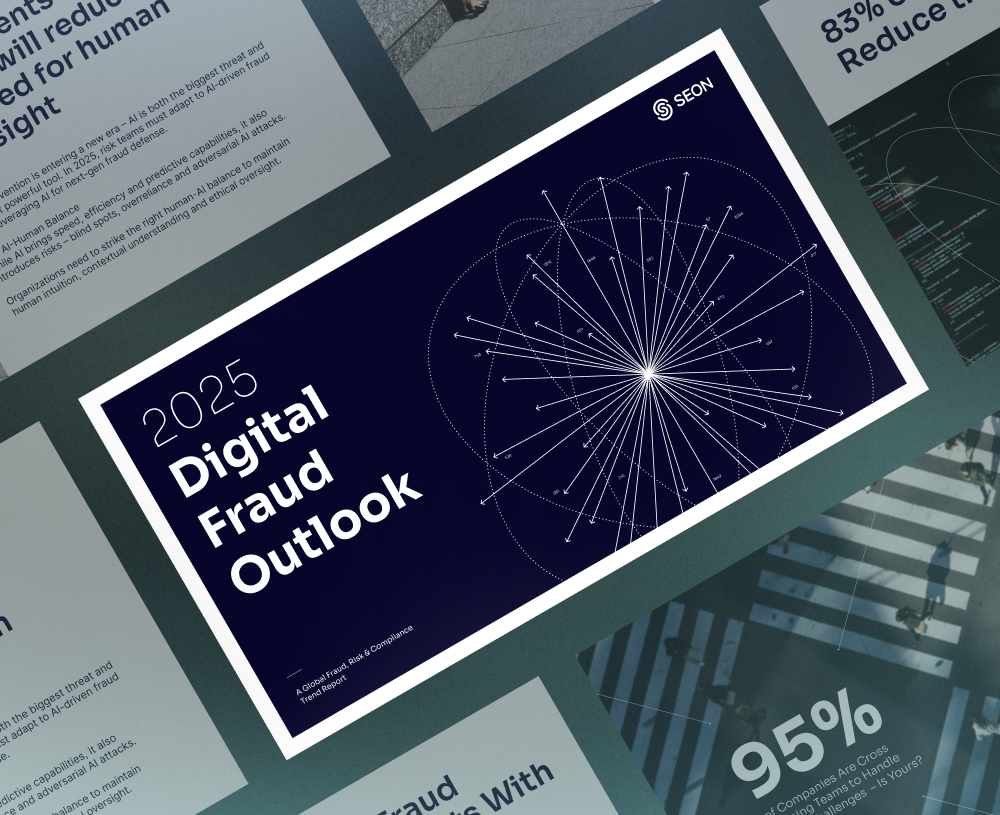This guide explains what fraud detection is, why it matters, and how organizations use it to protect against financial crime. You’ll learn about the main types of fraud, the methods used to detect and prevent it, and real-world examples that show how modern systems work in practice.
What Is Fraud Detection?
Fraud detection is the process of identifying and preventing suspicious or unauthorized activity that may indicate fraudulent behavior, particularly in financial transactions and online interactions. It involves analyzing data for anomalies, monitoring transactions in real time, and flagging irregular patterns that suggest potential fraud.
Adaptive and predictive analytics, supported by machine learning (ML) models, are widely used to score activities according to risk factors and detect potential threats as they emerge. This approach enables continuous monitoring and faster response to evolving fraud patterns.
Understanding the Main Types of Financial Fraud
Fraud can take many forms across industries, adapting to different business models and customer touchpoints. However, some attack types appear more frequently than others and are important to understand when building an effective detection strategy.
- Identity fraud: Account takeovers, fake accounts, and the use of stolen IDs. Attackers often rely on phishing emails, credential stuffing, or breached data to impersonate legitimate users. The end goal is usually to steal money, data, or both.
- Banking fraud: Financial institutions are frequent targets for loan fraud, forged checks, and other schemes designed to bypass controls. These attacks not only drain funds but also erode customer trust.
- Insurance fraud: False claims, staged accidents, and inflated reports cost providers billions each year. Fraudsters exploit gaps in claims review processes, making it harder for insurers to separate genuine customers from opportunistic actors. This type of fraud directly impacts premiums and customer satisfaction.
- Investment fraud: These scams, including Ponzi schemes, promise exceptionally high returns to attract investors. Instead of producing real profits, money from new participants is used to pay earlier ones, creating the illusion of success until the scheme collapses — leaving victims with significant financial losses and limited recourse.
- Romance and phishing scams: Fraudsters exploit human emotions to build trust, then trick victims into sharing credentials or transferring money. These scams target individuals through manipulation and deception, often leading to stolen personal or financial data.
- Transaction fraud: From credit card theft and chargebacks to refund and return abuse, criminals continuously exploit weaknesses in payment systems. Businesses are often forced to absorb the cost of disputes, fees, and inventory loss. This type of fraud remains especially damaging for eCommerce, retail, and subscription models.
- Bonus and affiliate abuse: Fraudsters manipulate promotional offers or affiliate programs for personal gain. Common tactics include creating linked accounts to benefit from sign-up bonuses or generating fake traffic to inflate partner earnings. Industries with high customer acquisition volumes are especially vulnerable to this type of abuse.
Recognizing these forms of fraud is essential for building detection systems that can identify risk signals early and adapt to emerging threats.
How to Detect and Prevent Fraud
Detecting and preventing fraud requires a mix of technology, human insight, and continuous risk management. Below are key strategies organizations use to identify threats early and reduce financial losses.
Fraud Detection Methods
Effective fraud detection combines behavioral analytics, device intelligence, and data enrichment to uncover anomalies before they cause harm. Modern systems analyze real-time data across multiple sources to identify unusual activity patterns, linked accounts, and high-risk signals that indicate potential fraud.
- Anti-fraud technology and transaction monitoring: A strong detection framework brings together data points such as device information, IP, and behavioral activity to spot inconsistencies and verify legitimate users. Real-time transaction monitoring tools analyze payment velocity, geolocation mismatches, and digital fingerprinting to identify abnormal behavior the instant it happens, helping block fraud before financial losses occur.
- AI-driven rules and machine learning: Adaptive AI and machine learning models process large volumes of transaction and behavioral data to surface hidden correlations. They continuously learn from labeled outcomes, refining rules and risk scores to improve precision over time. By combining human oversight with automated decisioning, businesses can detect both known and emerging threats more accurately.
- Device intelligence and behavioral analytics: Advanced device intelligence allows systems to detect fraudsters early by tracking device configurations, behavioral biometrics, and activity anomalies. Monitoring mouse movement, typing cadence, or unusual software environments helps detect bots, automation tools, and coordinated fraud attempts across multiple accounts, reducing false positives while maintaining user experience.
Fraud Prevention Framework
Fraud prevention stops bad actors before they reach the transaction stage. It combines proactive data enrichment, user education, and structured controls to ensure only legitimate customers move through digital channels.
- Education and awareness: Training employees and customers to recognize phishing, social engineering, and account takeover attempts builds a culture of vigilance that supports technical defenses.
- Digital footprint analysis and pre-screening: By analyzing data such as email, phone, IP, and device details during onboarding, businesses can build a reliable digital footprint for each user before KYC. This pre-screening approach helps identify synthetic identities, linked accounts, or high-risk users early, reducing manual reviews and keeping onboarding friction low.
- AI-powered prevention and feedback loops: Machine learning systems improve prevention by learning from confirmed fraud cases. Transaction labeling, risk scoring, and rule optimization create feedback loops that make models more accurate over time. Predictive analytics and shared consortium data add further protection by spotting coordinated fraud rings across industries.
- Building a structured prevention framework: A strong prevention strategy sets clear ownership and processes, supported by the right tools, specialized teams, and defined risk policies. It should ensure compliance with AML, GDPR, and CDD, include a dedicated MLRO where required, and establish quick response procedures for handling fraud incidents.
Together, these measures allow organizations to detect suspicious activity early, prevent fraud attempts before losses occur, and maintain trust across the entire customer lifecycle.
Key Components of a Fraud Detection System
A well-structured fraud detection system brings together multiple layers, from data collection and model training to compliance and performance monitoring. Each element plays a role in ensuring decisions are accurate, explainable, and scalable as threats evolve.
- Data collection and aggregation: Connect data from internal and external sources, including transactions, device signals, and user behavior, to create a unified view for anomaly detection.
- Feature engineering and model training: Use machine learning models trained on historical and real-time data to identify hidden fraud patterns and continuously refine accuracy.
- Customizable rule systems: Enable fine-tuned rules that adapt to specific business models, risk profiles, and compliance needs.
- Data protection and regulatory alignment: Ensure adherence to frameworks such as GDPR, PSD2, AML, and KYC by securing data integrity and auditability.
- User experience and transparency: Modern systems should balance detection precision with smooth customer interactions and explainable decisions.
- Scalability and adaptability: Platforms must evolve with new fraud vectors and handle large data volumes without compromising speed or accuracy.
- Performance monitoring: Use KPIs and KRIs to evaluate detection accuracy, false-positive rates, and financial impact for continuous improvement.
Why Is Modern Fraud Detection Important
Fraud detection is critical for any online business, especially as cyber threats grow more sophisticated. With the rise of ecommerce and digital transactions, strong prevention strategies are essential.
Fraud affects every sector. PwC’s 2024 study found that 60% of organizations faced fraud losses, nearly 30% lost over $1M, 25% had operations disrupted, and 20% saw morale drop. With hackers behind 32% of incidents and customers 28%, traditional methods aren’t enough—real-time detection technologies are now a must.
Evaluating the Complete Impact of Fraud Costs
In today’s connected digital economy, fraud has become a complex challenge that affects nearly every business function — from compliance and operations to marketing and customer experience. Global fraud losses now exceed $5.13 trillion annually, as technologies like AI enable criminals to exploit digital vulnerabilities. Beyond direct financial loss, indirect costs such as operational inefficiencies, customer churn, and regulatory penalties further amplify the impact. As organizations scale, adopting integrated, AI-powered fraud prevention systems is essential to reduce total fraud costs, protect customer trust, and maintain sustainable growth.
Discover fraud’s hidden costs and its impact on growth, efficiency, and trust.
Learn more here
Key Challenges in Fraud Detection
Fraud detection involves identifying suspicious activities and fraudulent behaviors before they cause damage. It’s the first line of defense in your anti-fraud strategy, but it presents unique challenges:
False positives and customer friction
Excessive false positives frustrate genuine customers and disrupt revenue. Balancing sensitivity with user experience requires continuous tuning of rules and models.
Evolving fraud tactics
Attackers constantly adapt their methods, forcing detection models to evolve and retrain to stay effective. Without frequent updates, even strong systems risk falling behind.
Data quality and accuracy
Incomplete, mislabeled, or biased data can degrade AI model performance. Maintaining clean, representative data is essential for reliable risk scoring.
High data volume and real-time demand
Processing large transaction datasets in real time remains one of the toughest technical challenges, especially for global, high-frequency businesses.
Integration and scalability
Implementing detection systems across multiple channels and legacy infrastructures can be complex, requiring flexible APIs and scalable architecture.
Regulatory and compliance pressure
Meeting AML, GDPR, and regional data protection standards adds another layer of complexity, especially for cross-border operations.
Resource and expertise limitations
Many organizations lack the in-house specialists or budgets needed to build and maintain continuously improving fraud systems.
Addressing these challenges requires a combination of strong data management, adaptive machine learning, and well-trained analysts to keep systems responsive as threats evolve.
To Sum Up Fraud Identification
With a growing number of fraud detection tools available on the market, it can be easy for merchants to be confused. It is bad enough that companies have to deal with relentless attacks, on top of that they must now face the challenge of vetting the right solution as an important business decision.
Hopefully, this guide will serve as a good primer. By now, you should have a clearer idea of which tools make sense for your company. And remember that remaining informed, whether it’s about the latest attack techniques or cybersecurity tools, is always the best way to stay one step ahead of the fraudsters – and your competitors.
A Global Fraud, Risk & Compliance Trend Report
Explore critical insights and learn what it takes to combat fraud in today’s digital age.

Frequently Asked Questions
Fraud solutions can help you reduce chargeback rates, account takeover attempts (account hacking), and registration with fake IDs, amongst others. It can also help with compliance for KYC and AML checks.
For fraud detection to be effective, you need as much data as possible. That includes user data (device, IP address), payment data (card BIN, shipping address), and even behavior data (login attempts, password resets, etc.).
Implementing a fraud detection system starts with deploying tools that combine rules, machine learning, and real-time monitoring to catch suspicious activity early. To stay effective, run regular audits to fine-tune models, update thresholds, and analyze user behavior. Continuously monitor regulatory changes—such as AML, CDD, PCI DSS, and GDPR—to remain compliant, and scale your system as your business grows to address new fraud risks.
Sources:









